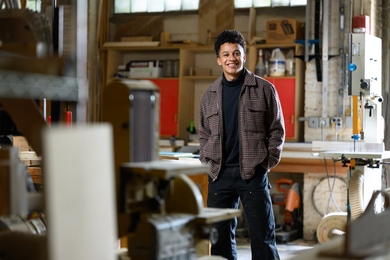The MIT Shaping the Future of Work Initiative, co-directed by MIT professors Daron Acemoglu, David Autor, and Simon Johnson, celebrated its official launch on Jan. 22. The new initiative’s mission is to analyze the forces that are eroding job quality and labor market opportunities for non-college workers and identify innovative ways to move the economy onto a more equitable trajectory. Here, Acemoglu, Autor, and Johnson speak about the origins, goals, and plans for their new initiative.
Q: What was the impetus for creating the MIT Shaping the Future of Work Initiative?
David Autor: The last 40 years have been increasingly difficult for the 65 percent of U.S. workers who do not have a four-year college degree. Globalization, automation, deindustrialization, de-unionization, and changes in policy and ideology have led to fewer jobs, declining wages, and lower job quality, resulting in widening inequality and shrinking opportunities.
The prevailing economic view has been that this erosion is inevitable — that the best we can do is focus on the supply side, educating workers to meet market demands, or perhaps providing some offsetting transfers to those who have lost employment opportunities.
Underpinning this fatalism is a paradigm which says that the factors shaping demand for work, such as technological change, are immutable: workers must adapt to these forces or be left behind. This assumption is false. The direction of technology is something we choose, and the institutions that shape how these forces play out (e.g., minimum wage laws, regulations, collective bargaining, public investments, social norms) are also endogenous.
To challenge a prevailing narrative, it is not enough to simply say that it is wrong — to truly change a paradigm we must lead by showing a viable alternative pathway. We must answer what sort of work we want and how we can make policies and shape technology that builds that future.
Q: What are your goals for the initiative?
Daron Acemoglu: The initiative's ambition is not modest. Simon, David, and I are hoping to make advances in new empirical work to interpret what has happened in the recent past and understand how different types of technologies could be impacting prosperity and inequality. We want to contribute to the emergence of a coherent framework that can inform us about how institutions and social forces shape the trajectory of technology, and that helps us to identify, empirically and conceptually, the inefficiencies and the misdirections of technology. And on this basis, we are hoping to contribute to policy discussions in which policy, institutions, and norms are part of what shapes the future of technology in a more beneficial direction. Last but not least, our mission is not just to do our own research, but to help build an ecosystem in which other, especially younger, researchers are inspired to explore these issues.
Q: What are your next steps?
Simon Johnson: David, Daron, and I plan for this initiative to move beyond producing insightful and groundbreaking research — our aim is to identify innovative pro-worker ideas that policymakers, the private sector, and civil society can use. We will continue to translate research into practice by regularly convening students, scholars, policymakers, and practitioners who are shaping the future of work — to include fortifying and diversifying the pipeline of emerging scholars who produce policy-relevant research around our core themes.
We will also produce a range of resources to bring our work to wider audiences. Last fall, David, Daron, and I wrote the initiative’s inaugural policy memo, entitled “Can we Have Pro-Worker AI? Choosing a path of machines in service of minds.” Our thesis is that, instead of focusing on replacing workers by automating job tasks as quickly as possible, the best path forward is to focus on developing worker-augmenting AI tools that enable less-educated or less-skilled workers to perform more expert tasks — as well as creating work, in the form of new productive tasks, for workers across skill and education levels.
As we move forward, we will also look for opportunities to engage globally with a wide range of scholars working on related issues.












